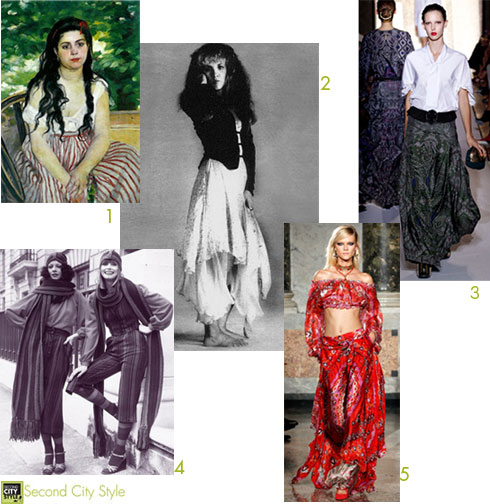
The emergence of a trend is a mysterious thing. How one thing becomes widely accepted and coveted while another doesn’t may involve many factors or it could be based off a single idea or lack thereof. It could be prescribed to us from high fashion designers and editors, or it could come from what is seen on the streets or possibly somewhere in between, where high and low fashion meet. But the fact remains that trends rise and fall and we take part in them in some form, even if it’s by refusing to buy into the trend at all. There are also trends that start off as a revolt against following trends. These rebellions that begin as an anti-fashion movement against the norm or the mainstream are the most interesting trend evolutions to watch. In the 80s it was punk, in the 90s it was the grunge scene and today it’s the hipster look. But before all of these non-trend trends there was the gypsy-style trend.
It may seem hard to imagine that the billowy skirts, peasant-style tops, oversized gold earrings and layered bangles were once part of an anti-fashion movement. It’s especially hard to imagine since the trend seems to resurface, like clockwork, every summer. While the clothing now is quite acceptable, it’s only become that way in modern history. Prior to the 1900s gypsies were people who, if not revolting against the “establishment” directly, they were not allowed into society because of their chosen lifestyle. Many gypsies (a name given to Romani nomadic people, often considered a slur) lived on the outskirts of society and moved around frequently and depended on their artistic abilities, such as dance, musical and storytelling performances to earn money. While the clothing they wore is not a mirror image of what we consider gypsy or bohemian today, the loose peasant blouse, long skirts and layering pieces were there. It was in the 1960s when hippies, who wanted to separate themselves from the politics of society, adopted the lifestyle and in effect the clothing of the gypsies, setting themselves apart.
During the 1960’s, when pencil skirts and kitten heels were of the utmost fashion, maxi dresses and large draping tops were decidedly anti-fashion. However, as the nontrend-trend grew and popular artists and musicians embraced the style, like Stevie Nicks who sings of being a gyspy, so too did the rest of society. No longer were the clothing pieces an indicator that one was against conforming to society’s ways, instead it was a trend for all to enjoy and have fun with. And still the trend evolves; the gypsy look is still as popular and designers across every level of fashion (high and low) create looks for everyone to partake. Emillo Pucci, YSL and other designers’ spring 2012 collections offer looks that are casual enough to wear daily or glam enough to dress up for an evening event, continuing the gypsy-style evolution.
1. Pierre-Auguste Renoir painting: The Bohemian, 1868, wikipedia.org
2. Stevie Nicks of Fleetwood Mac, fanpop.com
3. Yves Saint Laurent Spring 2012 RTW, style.com
4. 1970 Vintage Gypsy Fashion, luckyrabbitvintage.tumblr.com
5. Emilio Pucci Spring 2012 RTW, style.com
– Bonnie J Brown
Image Layout: Second City Style

